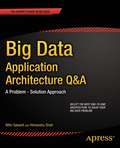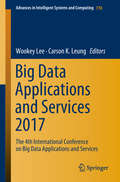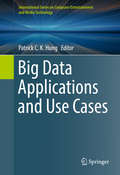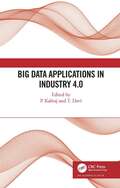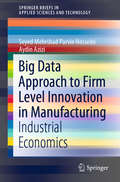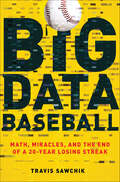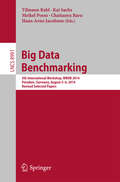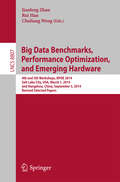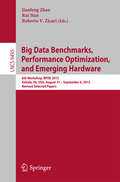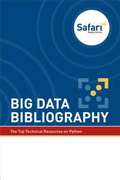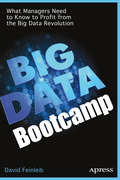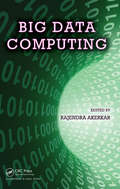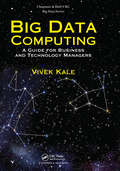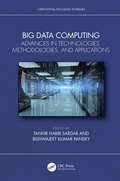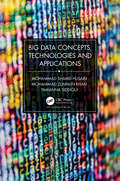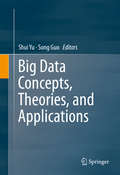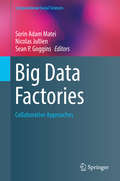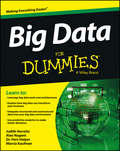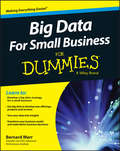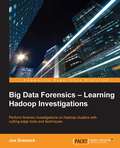- Table View
- List View
Big Data Application Architecture Q & A: A Problem - Solution Approach
by Nitin Sawant Himanshu ShahBig Data Application Architecture Pattern Recipes provides an insight into heterogeneous infrastructures, databases, and visualization and analytics tools used for realizing the architectures of big data solutions. Its problem-solution approach helps in selecting the right architecture to solve the problem at hand. In the process of reading through these problems, you will learn harness the power of new big data opportunities which various enterprises use to attain real-time profits. Big Data Application Architecture Pattern Recipes answers one of the most critical questions of this time 'how do you select the best end-to-end architecture to solve your big data problem?'. The book deals with various mission critical problems encountered by solution architects, consultants, and software architects while dealing with the myriad options available for implementing a typical solution, trying to extract insight from huge volumes of data in real-time and across multiple relational and non-relational data types for clients from industries like retail, telecommunication, banking, and insurance. The patterns in this book provide the strong architectural foundation required to launch your next big data application. The architectures for realizing these opportunities are based on relatively less expensive and heterogeneous infrastructures compared to the traditional monolithic and hugely expensive options that exist currently. This book describes and evaluates the benefits of heterogeneity which brings with it multiple options of solving the same problem, evaluation of trade-offs and validation of 'fitness-for-purpose' of the solution.
Big Data Applications and Services 2017: The 4th International Conference on Big Data Applications and Services (Advances in Intelligent Systems and Computing #770)
by Wookey Lee Carson K. LeungThis proceedings volume contains selected papers from the Fourth International Conference on Big Data Applications and Services (BigDAS 2017), held in Tashkent, Uzbekistan on August 15-18, 2017. Big data has become a core technology providing innovative solutions in many fields including social media, healthcare and manufacturing. The Fourth International Conference on Big Data Applications and Services (BigDAS 2017) presented innovative results, encouraged academic and industrial interaction, and promoted collaborative research in the field of big data worldwide. The conference was organized by the Korea Big Data Services Society and National University of Uzbekistan.
Big Data Applications and Use Cases (International Series on Computer Entertainment and Media Technology)
by Patrick C. K. HungThis book presents different use cases in big data applications and related practical experiences. Many businesses today are increasingly interested in utilizing big data technologies for supporting their business intelligence so that it is becoming more and more important to understand the various practical issues from different practical use cases. This book provides clear proof that big data technologies are playing an ever increasing important and critical role in a new cross-discipline research between computer science and business.
Big Data Applications in Industry 4.0
by P. KalirajIndustry 4.0 is the latest technological innovation in manufacturing with the goal to increase productivity in a flexible and efficient manner. Changing the way in which manufacturers operate, this revolutionary transformation is powered by various technology advances including Big Data analytics, Internet of Things (IoT), Artificial Intelligence (AI), and cloud computing. Big Data analytics has been identified as one of the significant components of Industry 4.0, as it provides valuable insights for smart factory management. Big Data and Industry 4.0 have the potential to reduce resource consumption and optimize processes, thereby playing a key role in achieving sustainable development. Big Data Applications in Industry 4.0 covers the recent advancements that have emerged in the field of Big Data and its applications. The book introduces the concepts and advanced tools and technologies for representing and processing Big Data. It also covers applications of Big Data in such domains as financial services, education, healthcare, biomedical research, logistics, and warehouse management. Researchers, students, scientists, engineers, and statisticians can turn to this book to learn about concepts, technologies, and applications that solve real-world problems. Features An introduction to data science and the types of data analytics methods accessible today An overview of data integration concepts, methodologies, and solutions A general framework of forecasting principles and applications, as well as basic forecasting models including naïve, moving average, and exponential smoothing models A detailed roadmap of the Big Data evolution and its related technological transformation in computing, along with a brief description of related terminologies The application of Industry 4.0 and Big Data in the field of education The features, prospects, and significant role of Big Data in the banking industry, as well as various use cases of Big Data in banking, finance services, and insurance Implementing a Data Lake (DL) in the cloud and the significance of a data lake in decision making
Big Data Approach to Firm Level Innovation in Manufacturing: Industrial Economics (SpringerBriefs in Applied Sciences and Technology)
by Aydin Azizi Seyed Mehrshad Parvin HosseiniThis book discusses utilizing Big Data and Machine Learning approaches in investigating five aspects of firm level innovation in manufacturing; (1) factors that determine the decision to innovate (2) the extent of innovation (3) characteristics of an innovating firm (4) types of innovation undertaken and (5) the factors that drive and enable different types of innovation. A conceptual model and a cost-benefit framework were developed to explain a firm’s decision to innovate. To empirically demonstrate these aspects, Big data and machine learning approaches were introduced in the form of a case study. The result of Big data analysis as an inferior method to analyse innovation data was also compared with the results of conventional statistical methods. The implications of the findings of the study for increasing the pace of innovation are also discussed.
Big Data Architect’s Handbook: A guide to building proficiency in tools and systems used by leading big data experts
by Syed Muhammad AkhtarA comprehensive end-to-end guide that gives hands-on practice in big data and Artificial IntelligenceKey FeaturesLearn to build and run a big data application with sample codeExplore examples to implement activities that a big data architect performsUse Machine Learning and AI for structured and unstructured dataBook DescriptionThe big data architects are the “masters” of data, and hold high value in today’s market. Handling big data, be it of good or bad quality, is not an easy task. The prime job for any big data architect is to build an end-to-end big data solution that integrates data from different sources and analyzes it to find useful, hidden insights.Big Data Architect’s Handbook takes you through developing a complete, end-to-end big data pipeline, which will lay the foundation for you and provide the necessary knowledge required to be an architect in big data. Right from understanding the design considerations to implementing a solid, efficient, and scalable data pipeline, this book walks you through all the essential aspects of big data. It also gives you an overview of how you can leverage the power of various big data tools such as Apache Hadoop and ElasticSearch in order to bring them together and build an efficient big data solution.By the end of this book, you will be able to build your own design system which integrates, maintains, visualizes, and monitors your data. In addition, you will have a smooth design flow in each process, putting insights in action.What you will learn Learn Hadoop Ecosystem and Apache projects Understand, compare NoSQL database and essential software architecture Cloud infrastructure design considerations for big data Explore application scenario of big data tools for daily activities Learn to analyze and visualize results to uncover valuable insights Build and run a big data application with sample code from end to end Apply Machine Learning and AI to perform big data intelligence Practice the daily activities performed by big data architectsWho this book is forBig Data Architect’s Handbook is for you if you are an aspiring data professional, developer, or IT enthusiast who aims to be an all-round architect in big data. This book is your one-stop solution to enhance your knowledge and carry out easy to complex activities required to become a big data architect.
Big Data Baseball: Math, Miracles, and the End of a 20-Year Losing Streak
by Travis SawchikBig Data Baseball provides a behind-the-scenes look at how the Pittsburgh Pirates used big data strategies to end the longest losing streak in North American pro sports history.New York Times BestsellerAfter twenty consecutive losing seasons for the Pittsburgh Pirates, team morale was low, the club’s payroll ranked near the bottom of the sport, game attendance was down, and the city was becoming increasingly disenchanted with its team. Big Data Baseball is the story of how the 2013 Pirates, mired in the longest losing streak in North American pro sports history, adopted drastic big-data strategies to end the drought, make the playoffs, and turn around the franchise’s fortunes.Big Data Baseball is Moneyball for a new generation. Award-winning journalist Travis Sawchik takes you behind the scenes to expertly weave together the stories of the key figures who changed the way the Pirates played the game, revealing how a culture of collaboration and creativity flourished as whiz-kid analysts worked alongside graybeard coaches to revolutionize the sport and uncover groundbreaking insights for how to win more games without spending a dime.From pitch framing to on-field shifts, this entertaining and enlightening underdog story closely examines baseball’s burgeoning big data movement and demonstrates how the millions of data points which aren’t immediately visible to players and spectators, are the bit of magic that led the Pirates to finish the 2013 season in second place and brought an end to a twenty-year losing streak.
Big Data Benchmarking: 5th International Workshop, WBDB 2014, Potsdam, Germany, August 5-6- 2014, Revised Selected Papers (Lecture Notes in Computer Science #8991)
by Chaitanya Baru Tilmann Rabl Kai Sachs Meikel Poess Hans-Arno JacobsonThis book constitutes the thoroughly refereed post-workshop proceedings of the 5th International Workshop on Big Data Benchmarking, WBDB 2014, held in Potsdam, Germany, in August 2014. The 13 papers presented in this book were carefully reviewed and selected from numerous submissions and cover topics such as benchmarks specifications and proposals, Hadoop and MapReduce - in the different context such as virtualization and cloud - as well as in-memory, data generation, and graphs.
Big Data Benchmarking: 6th International Workshop, WBDB 2015, Toronto, ON, Canada, June 16-17, 2015 and 7th International Workshop, WBDB 2015, New Delhi, India, December 14-15, 2015, Revised Selected Papers (Lecture Notes in Computer Science #10044)
by Tilmann Rabl, Raghunath Nambiar, Chaitanya Baru, Milind Bhandarkar, Meikel Poess and Saumyadipta PyneThis book constitutes the thoroughly refereed post-workshop proceedings of the 6th International Workshop on Big Data Benchmarking, WBDB 2015, held in Toronto, ON, Canada, in June 2015 and the 7th International Workshop, WBDB 2015, held in New Delhi, India, in December 2015. The 8 full papers presented in this book were carefully reviewed and selected from 22 submissions. They deal with recent trends in big data and HPC convergence, new proposals for big data benchmarking, as well as tooling and performance results.
Big Data Benchmarks, Performance Optimization, and Emerging Hardware: 4th and 5th Workshops, BPOE 2014, Salt Lake City, USA, March 1, 2014 and Hangzhou, China, September 5, 2014, Revised Selected Papers (Lecture Notes in Computer Science #8807)
by Jianfeng Zhan Rui Han Chuliang WengThis book constitutes the thoroughly revised selected papers of the 4th and 5th workshops on Big Data Benchmarks, Performance Optimization, and Emerging Hardware, BPOE 4 and BPOE 5, held respectively in Salt Lake City, in March 2014, and in Hangzhou, in September 2014. The 16 papers presented were carefully reviewed and selected from 30 submissions. Both workshops focus on architecture and system support for big data systems, such as benchmarking; workload characterization; performance optimization and evaluation; emerging hardware.
Big Data Benchmarks, Performance Optimization, and Emerging Hardware: 6th Workshop, BPOE 2015, Kohala, HI, USA, August 31 - September 4, 2015. Revised Selected Papers (Lecture Notes in Computer Science #9495)
by Jianfeng Zhan Rui Han Roberto V. ZicariThis book constitutes the thoroughly revised selectedpapers of the 6th workshop on Big Data Benchmarks, Performance Optimization,and Emerging Hardware, BPOE 2015, held in Kohala Coast, HI, USA, inAugust/September 2015 as satellite event of VLDB 2015, the 41st InternationalConference on Very Large Data Bases. The 8 papers presented were carefully reviewedand selected from 10 submissions. The workshop focuses on architecture andsystem support for big data systems, aiming at bringing researchers andpractitioners from data management, architecture, and systems researchcommunities together to discuss the research issues at the intersection ofthese areas. This book also invites three papers from several industrialpartners, including two papers describing tools used in system benchmarking andmonitoring and one paper discussing principles and methodologies in existingbig data benchmarks.
Big Data Bibliography
by Safari Books Online Content TeamThe exponentially decreasing costs of data storage combined with the soaring volume of data being captured presents challenges and opportunities to those who work in the new frontiers of data science. Businesses, government agencies, and scientists leveraging data-based decisions are more successful than those relying on decades of trial-and-error. But taming and harnessing big data can be a herculean undertaking. The data must be collected, processed and distilled, analyzed, and presented in a manner humans can understand. Because there are no degrees in data science, data scientists must grow into their roles. If you are looking for resources to help you better understand big data and analytics, this is your guide. Tap into books and videos that cover everything from business intelligence to data mining and machine learning, to cloud services and NoSql Data Stores to data visualization.
Big Data Bootcamp: What Managers Need to Know to Profit from the Big Data Revolution
by David FeinleibInvestors and technology gurus have called big data one of the most important trends to come along in decades. Big Data Bootcamp explains what big data is and how you can use it in your company to become one of tomorrow's market leaders. Along the way, it explains the very latest technologies, companies, and advancements. Big data holds the keys to delivering better customer service, offering more attractive products, and unlocking innovation. That's why, to remain competitive, every organization should become a big data company. It's also why every manager and technology professional should become knowledgeable about big data and how it is transforming not just their own industries but the global economy. And that knowledge is just what this book delivers. It explains components of big data like Hadoop and NoSQL databases; how big data is compiled, queried, and analyzed; how to create a big data application; and the business sectors ripe for big data-inspired products and services like retail, healthcare, finance, and education. Best of all, your guide is David Feinleib, renowned entrepreneur, venture capitalist, and author of Why Startups Fail. Feinleib's Big Data Landscape, a market map featured and explained in the book, is an industry benchmark that has been viewed more than 150,000 times and is used as a reference by VMWare, Dell, Intel, the U. S. Government Accountability Office, and many other organizations. Feinleib also explains: * Why every businessperson needs to understand the fundamentals of big data or get run over by those who do * How big data differs from traditional database management systems * How to create and run a big data project * The technical details powering the big data revolution Whether you're a Fortune 500 executive or the proprietor of a restaurant or web design studio, Big Data Bootcamp will explain how you can take full advantage of new technologies to transform your company and your career. What you'll learn Which big data technologies are the most compelling and how to get started using them How the intersection of big data, cloud computing, and mobile technologies is opening up huge new markets and opportunities for entrepreneurs and existing businesses alike How to find and put to use valuable data sets How marketers can use big data applications to pinpoint and appeal to the most likely customers How to make much better decisions using big data Who this book is for The target audience for this book is business and IT professionals, investors, managers, entrepreneurs and small business owners, and government officials. Table of Contents Big Data The Big Data Landscape Your Big Data Roadmap Big Data at Work Why a Picture Is Worth a Thousand Words The Intersection of Big Data, Mobile, and Cloud Computing Doing a Big Data Project The Next Billion-Dollar IPO: Big Data Entrepreneurship Reach More Customers with Better Data--and Products How Big Data Is Changing the Way We Live Big Data Opportunities in Education Capstone Case Study: Big Data Meets Romance Big Data Resources
Big Data Challenges: Society, Security, Innovation and Ethics
by Anno Bunnik Anthony Cawley Michael Mulqueen Andrej ZwitterThis book brings together an impressive range of academic and intelligence professional perspectives to interrogate the social, ethical and security upheavals in a world increasingly driven by data. Written in a clear and accessible style, it offers fresh insights to the deep reaching implications of Big Data for communication, privacy and organisational decision-making. It seeks to demystify developments around Big Data before evaluating their current and likely future implications for areas as diverse as corporate innovation, law enforcement, data science, journalism, and food security. The contributors call for a rethinking of the legal, ethical and philosophical frameworks that inform the responsibilities and behaviours of state, corporate, institutional and individual actors in a more networked, data-centric society. In doing so, the book addresses the real world risks, opportunities and potentialities of Big Data.
Big Data Computing
by Rajendra AkerkarDue to market forces and technological evolution, Big Data computing is developing at an increasing rate. A wide variety of novel approaches and tools have emerged to tackle the challenges of Big Data, creating both more opportunities and more challenges for students and professionals in the field of data computation and analysis. Presenting a mix
Big Data Computing and Communications: Second International Conference, BigCom 2016, Shenyang, China, July 29-31, 2016. Proceedings (Lecture Notes in Computer Science #9784)
by Zhu Han Yu Wang Yanyong Zhang Ge Yu Guoren WangThis book constitutes the proceedings of the First International Conference on Big Data Computing and Communications, BigCom 2015, held in Taiyuan, China, in August 2015. The 41 papers presented in this volume were carefully reviewed and selected from 74 submissions. They were organized in topical sections named: wireless communication and networks; database and big data; smart phone and sensing application; security and privacy; architecture and applications; sensor networks and RFID; social networks and recommendation; signal processing and pattern recognition; and routing and resource management.
Big Data Computing: A Guide for Business and Technology Managers (Chapman & Hall/CRC Big Data Series)
by Vivek KaleThis book unravels the mystery of Big Data computing and its power to transform business operations. The approach it uses will be helpful to any professional who must present a case for realizing Big Data computing solutions or to those who could be involved in a Big Data computing project. It provides a framework that enables business and technical managers to make optimal decisions necessary for the successful migration to Big Data computing environments and applications within their organizations.
Big Data Computing: Advances in Technologies, Methodologies, and Applications (Computational Intelligence Techniques)
by Bishwajeet Kumar Pandey Tanvir Habib SardarThis book primarily aims to provide an in-depth understanding of recent advances in big data computing technologies, methodologies, and applications along with introductory details of big data computing models such as Apache Hadoop, MapReduce, Hive, Pig, Mahout in-memory storage systems, NoSQL databases, and big data streaming services such as Apache Spark, Kafka, and so forth. It also covers developments in big data computing applications such as machine learning, deep learning, graph processing, and many others. Features: Provides comprehensive analysis of advanced aspects of big data challenges and enabling technologies. Explains computing models using real-world examples and dataset-based experiments. Includes case studies, quality diagrams, and demonstrations in each chapter. Describes modifications and optimization of existing technologies along with the novel big data computing models. Explores references to machine learning, deep learning, and graph processing. This book is aimed at graduate students and researchers in high-performance computing, data mining, knowledge discovery, and distributed computing.
Big Data Concepts, Technologies, and Applications
by Mohammad Shahid Husain Mohammad Zunnun Khan Tamanna SiddiquiWith the advent of such advanced technologies as cloud computing, the Internet of Things, the Medical Internet of Things, the Industry Internet of Things and sensor networks as well as the exponential growth in the usage of Internet-based and social media platforms, there are enormous oceans of data. These huge volumes of data can be used for effective decision making and improved performance if analyzed properly. Due to its inherent characteristics, big data is very complex and cannot be handled and processed by traditional database management approaches. There is a need for sophisticated approaches, tools and technologies that can be used to store, manage and analyze these enormous amounts of data to make the best use of them. Big Data Concepts, Technologies, and Applications covers the concepts, technologies, and applications of big data analytics. Presenting the state-of-the-art technologies in use for big data analytics. it provides an in-depth discussion about the important sectors where big data analytics has proven to be very effective in improving performance and helping industries to remain competitive. This book provides insight into the novel areas of big data analytics and the research directions for the scholars working in the domain. Highlights include: The advantages, disadvantages and challenges of big data analytics State-of-the-art technologies for big data analytics such as Hadoop, NoSQL databases, data lakes, deep learning and blockchain The application of big data analytic in healthcare, business, social media analytics, fraud detection and prevention and governance Exploring the concepts and technologies behind big data analytics, the book is an ideal resource for researchers, students, data scientists, data analysts and business analysts who need insight into big data analytics
Big Data Concepts, Theories, and Applications
by Shui Yu Song GuoThisbook covers three major parts of Big Data: concepts, theories andapplications. Written by world-renowned leaders in Big Data, this book exploresthe problems, possible solutions and directions for Big Data in research andpractice. It also focuses on high level concepts such as definitionsof Big Data from different angles; surveys in research and applications; andexisting tools, mechanisms, and systems in practice. Each chapter is independentfrom the other chapters, allowing users to read any chapter directly. After examining the practical sideof Big Data, this book presents theoretical perspectives. The theoreticalresearch ranges from Big Data representation, modeling and topology todistribution and dimension reducing. Chapters also investigate the manydisciplines that involve Big Data, such as statistics, data mining, machinelearning, networking, algorithms, security and differential geometry. The lastsection of this book introduces Big Data applications from differentcommunities, such as business, engineering and science. Big Data Concepts, Theories and Applications is designed as a reference for researchersand advanced level students in computer science, electrical engineering andmathematics. Practitioners who focus on information systems, big data, datamining, business analysis and other related fields will also find thismaterial valuable.
Big Data Factories: Collaborative Approaches (Computational Social Sciences)
by Sean P. Goggins Sorin Adam Matei Nicolas JullienThe book proposes a systematic approach to big data collection, documentation and development of analytic procedures that foster collaboration on a large scale. This approach, designated as "data factoring" emphasizes the need to think of each individual dataset developed by an individual project as part of a broader data ecosystem, easily accessible and exploitable by parties not directly involved with data collection and documentation. Furthermore, data factoring uses and encourages pre-analytic operations that add value to big data sets, especially recombining and repurposing. The book proposes a research-development agenda that can undergird an ideal data factory approach. Several programmatic chapters discuss specialized issues involved in data factoring (documentation, meta-data specification, building flexible, yet comprehensive data ontologies, usability issues involved in collaborative tools, etc. ). The book also presents case studies for data factoring and processing that can lead to building better scientific collaboration and data sharing strategies and tools. Finally, the book presents the teaching utility of data factoring and the ethical and privacy concerns related to it. Chapter 9 of this book is available open access under a CC BY 4. 0 license at link. springer. com
Big Data Finance in China (Contributions to Finance and Accounting)
by Wei Chen Wenting Zhang Mengyao LinThis book starts by introducing the background of the era of data elements, clarifies the theoretical basis and technical methods related to big data, and analyzes the specific application of big data technology in China’s banking industry, the insurance industry, securities investment industry, third-party payment, risk supervision, and other fields. application, and thereby finally summarize useful experiences for big data development as well as effective regulation and supervision. We hope that this book can help with subsequent research and application of big data technology in the financial field. This book has a broad audience, especially scholars and practitioners. It is a valuable reference for researchers in related fields, and it can also provide some insights into financial regulators’ awareness of big data finance. Furthermore, it aids in formulating and improving consumption policies, adjusting economic structures, and preventing risks under financial innovation. This research provides valuable guidance for improving financial innovation as well as the effective regulation thereon by financial regulators.
Big Data For Dummies
by Marcia Kaufman Fern Halper Hurwitz Alan NugentFind the right big data solution for your business or organizationBig data management is one of the major challenges facing business, industry, and not-for-profit organizations. Data sets such as customer transactions for a mega-retailer, weather patterns monitored by meteorologists, or social network activity can quickly outpace the capacity of traditional data management tools. If you need to develop or manage big data solutions, you'll appreciate how these four experts define, explain, and guide you through this new and often confusing concept. You'll learn what it is, why it matters, and how to choose and implement solutions that work.Effectively managing big data is an issue of growing importance to businesses, not-for-profit organizations, government, and IT professionalsAuthors are experts in information management, big data, and a variety of solutionsExplains big data in detail and discusses how to select and implement a solution, security concerns to consider, data storage and presentation issues, analytics, and much moreProvides essential information in a no-nonsense, easy-to-understand style that is empoweringBig Data For Dummies cuts through the confusion and helps you take charge of big data solutions for your organization.
Big Data For Small Business For Dummies
by Bernard MarrCapitalise on big data to add value to your small business Written by bestselling author and big data expert Bernard Marr, Big Data For Small Business For Dummies helps you understand what big data actually is--and how you can analyse and use it to improve your business. Free of confusing jargon and complemented with lots of step-by-step guidance and helpful advice, it quickly and painlessly helps you get the most from using big data in a small business. Business data has been around for a long time. Unfortunately, it was trapped away in overcrowded filing cabinets and on archaic floppy disks. Now, thanks to technology and new tools that display complex databases in a much simpler manner, small businesses can benefit from the big data that's been hiding right under their noses. With the help of this friendly guide, you'll discover how to get your hands on big data to develop new offerings, products and services; understand technological change; create an infrastructure; develop strategies; and make smarter business decisions. Shows you how to use big data to make sense of user activity on social networks and customer transactions Demonstrates how to capture, store, search, share, analyse and visualise analytics Helps you turn your data into actionable insights Explains how to use big data to your advantage in order to transform your small business If you're a small business owner or employee, Big Data For Small Business For Dummies helps you harness the hottest commodity on the market today in order to take your company to new heights.
Big Data Forensics – Learning Hadoop Investigations
by Joe SremackPerform forensic investigations on Hadoop clusters with cutting-edge tools and techniques About This Book * Identify, collect, and analyze Hadoop evidence forensically. * Learn about Hadoop's internals and Big Data file storage concepts * A step by step guide to help you perform forensic analysis using freely available tools Who This Book Is For This book is meant for statisticians and forensic analysts with basic knowledge of digital forensics. They do not need to know Big Data Forensics. If you are an IT professional, law enforcement professional, legal professional, or a student interested in Big Data and forensics, this book is the perfect hands-on guide for learning how to conduct Hadoop forensic investigations. Each topic and step in the forensic process is described in accessible language. What You Will Learn * Understand Hadoop internals and file storage * Collect and analyze Hadoop forensic evidence * Perform complex forensic analysis for fraud and other investigations * Use state-of-the-art forensic tools * Conduct interviews to identify Hadoop evidence * Create compelling presentations of your forensic findings * Understand how Big Data clusters operate * Apply advanced forensic techniques in an investigation, including file carving, statistical analysis, and more In Detail Big Data forensics is an important type of digital investigation that involves the identification, collection, and analysis of large-scale Big Data systems. Hadoop is one of the most popular Big Data solutions, and forensically investigating a Hadoop cluster requires specialized tools and techniques. With the explosion of Big Data, forensic investigators need to be prepared to analyze the petabytes of data stored in Hadoop clusters. Understanding Hadoop's operational structure and performing forensic analysis with court-accepted tools and best practices will help you conduct a successful investigation. Discover how to perform a complete forensic investigation of large-scale Hadoop clusters using the same tools and techniques employed by forensic experts. This book begins by taking you through the process of forensic investigation and the pitfalls to avoid. It will walk you through Hadoop's internals and architecture, and you will discover what types of information Hadoop stores and how to access that data. You will learn to identify Big Data evidence using techniques to survey a live system and interview witnesses. After setting up your own Hadoop system, you will collect evidence using techniques such as forensic imaging and application-based extractions. You will analyze Hadoop evidence using advanced tools and techniques to uncover events and statistical information. Finally, data visualization and evidence presentation techniques are covered to help you properly communicate your findings to any audience. Style and approach This book is a complete guide that follows every step of the forensic analysis process in detail. You will be guided through each key topic and step necessary to perform an investigation. Hands-on exercises are presented throughout the book, and technical reference guides and sample documents are included for real-world use.
